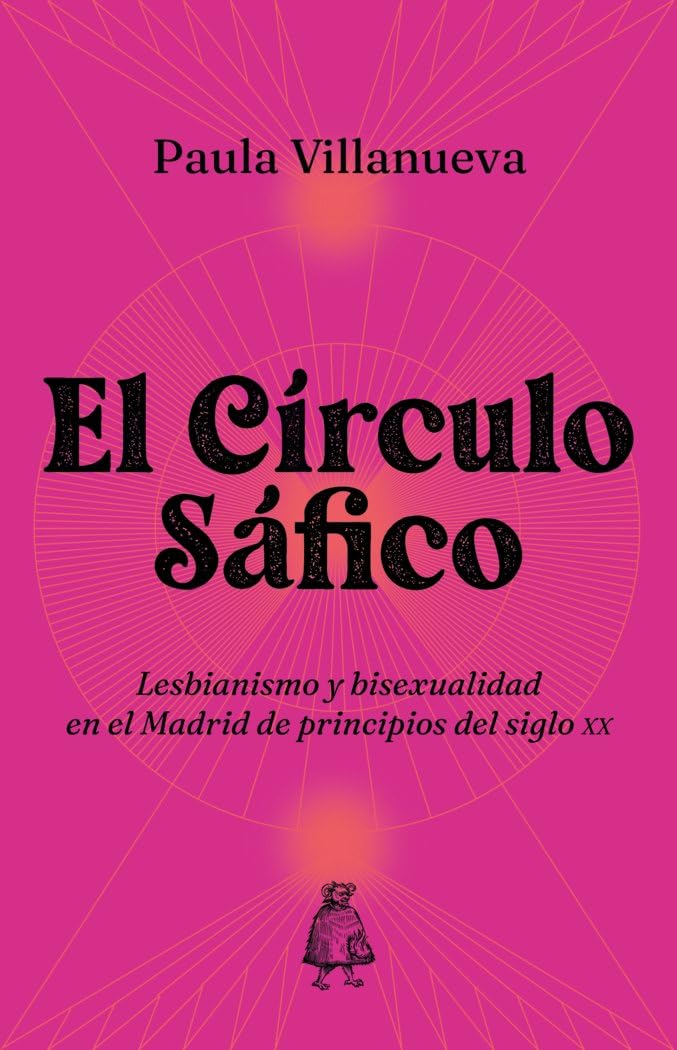
The Sapphic Circle: Lesbianism and Bisexuality in Madrid at the Beginning of the Twentieth Century
Paula Villanueva
Levanta Fuego, 2024, 288 pages
$19.60
Reviewed by Angela Acosta
Lea esta reseña en español
Sapphic women in Spain who lived between the nineteenth and twentieth centuries formed a core group of avant-garde writers and artists, and after a dictatorship and various methods of censorship and erasure, we can finally name and get to know them in the twenty-first century. The Sapphic Circle is the first educational book written for a general readership who don’t yet know the histories of lesbian and bisexual women at the beginning of the twentieth century, then called “inverts.” The points of departure for this volume on the networks of epistolary correspondence, romance, and friendship among sapphic writers and artists are lesbian playwright Victorina Durán’s Así es (That Way), the third volume of her memoirs, and Vicente Carretón’s and Eva Moreno Lago’s research on the Sapphic Circle of Madrid and the circle that existed among women exiled in Buenos Aires.
Paula Villanueva recovers sapphic women’s names and texts—some of which already appear in Tània Balló’s Las Sinsombrero (The Hatless Women) documentaries (2015, 2019, 2021)—through an exploration of female gathering spaces and a “who’s who of bisexuals and lesbians” that comprises most of the work (119; All translations in this review are my own). These names include Countess Gloria Laguna, Ángeles Vicente, Elena Fortún, Victoria Kent, Lucía Sánchez Saornil, Rosa Chacel, Victorina Durán, Carmen Conde, and their partners. These sapphic women were vital contributors to the Spanish modernist milieu along with Federico García Lorca and Luis Cernuda, the most famous queer male intellectuals of their generation. But it remains difficult to find evidence of these women in archives and textbooks about the “Generation of 1927” and “Silver Age” of Spanish literature.
While all of these women were white and the majority came from well-off families, the women discussed in this book represent a diverse range of experiences and expressions of gender and sexuality. To this end, Villanueva emphasizes the importance of social institutions in her chapter on the Female Lyceum Club and the Unmarried Women’s Residence in Madrid. These institutions provided education and friendships that would support their members for life, despite later closing due to the Spanish Civil War.
“In my opinion, diligence or custom is what created the Circle, rather than the previous view of the Sapphic Circle as an association that was [formally] founded, registered, or semi-institutionalized. The fact that sapphic women have needed and sought each other throughout history is obvious—just like gay or bisexual men [have done]—, and for this reason I consider that this [unstructured creation of the Circle by upper-class women seeking community] is where we need to focus” (88).
The Sapphic Circle brings together the fruits of contemporary scholarship on modern women in an accessible way, both in terms of language and in the presentation of the historical and cultural background. The preliminary chapters serve as an introduction to the concept of the modern woman and women’s groups. Villanueva contextualizes these avant-garde women who “directly challenged dichotomous and binary worldviews” (43) within conversations about the Western pathologization of sexuality, while also considering sapphic modernity in the English-speaking world as represented by works by Gertrude Stein and Radclyffe Hall’s The Well of Loneliness.
The book is not merely a literature review, but a detailed study of the personal and professional challenges faced by lesbian and bisexual women (including when their own relatives denied the relationships they had with other women), that at the same time questions why their sexuality remains unmentioned in some research studies. The book’s sections bring together already well-known names like Victorina Durán and Elena Fortún with women hardly mentioned even in academic conversations, such as Countess Gloria Laguna, for whom “lesbianism was a close friend” (125). These profiles of sapphic women strike a good balance between discussing sapphic texts—like Ángeles Vicente’s eponymous Zezé (1909) and Elena Fortún’s Oculto sendero (Hidden Path), (written between 1939 and 1948)—and discussing how these texts were inspired by the tertulias (social gatherings) and epistolary relationships that nurtured the lives of sapphic writers and artists.
The author’s voice is consistently present, guiding us through Madrid of the 1920s and 1930s and the Sapphic Circle of Buenos Aires that Victorina Durán established during her exile. Above all, I appreciate the care with which Villanueva tells love stories in times of war, describing jealous husbands like Antonio Oliver who destroyed some of Carmen Conde’s poems, as well as the “undeclared and conflicted bisexuality” (239) of actress Margarita Xirgu.
“We all need to forget, at least for a few hours, the violence of the world; in the same way that we need to inhabit a bubble in which our lives can be full, alongside friends and loves with whom we can share struggles, construct ourselves politically, and care for one another” (238).
I am deeply moved by the resounding solidarity and sisterhood among queer women on display in this book: from the political commitments of lawyer Victoria Kent and poet Lucía Sánchez Saornil to the courage with which Victorina Durán, Rosa Chacel, and Elena Fortún wrote about the sapphic networks of their generation. I hope that these modern women will inspire us to add more names and diverse voices to those of our “tribadic predecessors” (89) as we pay tribute to them in our research and poetry.
Angela Acosta, Ph.D. (she/her) is an Assistant Professor of Spanish at the University of South Carolina. Her poems have appeared in Yellow Arrow Publishing, Heartlines Spec, and Apparition Lit. She is co-editor with Dr. Rebecca Haidt of the Spanish Sapphic Modernity special issue of Feminist Modernist Studies (vol. 7, issue 3).